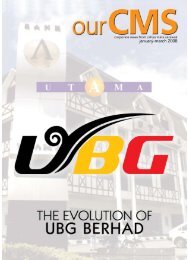Notes to the Financial Statements - Cahaya Mata Sarawak Bhd
Notes to the Financial Statements - Cahaya Mata Sarawak Bhd
Notes to the Financial Statements - Cahaya Mata Sarawak Bhd
You also want an ePaper? Increase the reach of your titles
YUMPU automatically turns print PDFs into web optimized ePapers that Google loves.
<strong>Notes</strong> <strong>to</strong> <strong>the</strong> <strong>Financial</strong> <strong>Statements</strong><br />
For <strong>the</strong> fi nancial year ended 31 December 2011<br />
43. <strong>Financial</strong> risk management objectives and policies (contd.)<br />
(a) Credit risk<br />
Credit risk is <strong>the</strong> risk of loss that may arise on outstanding fi nancial instruments should a counterparty<br />
default on its obligations. At <strong>the</strong> reporting date, <strong>the</strong> Group’s and <strong>the</strong> Company’s exposure <strong>to</strong> credit risk<br />
arises primarily from trade and o<strong>the</strong>r receivables.<br />
The Group’s objective is <strong>to</strong> seek continual revenue growth while minimising losses incurred due <strong>to</strong><br />
increased credit risk exposure. The Group trades only with recognised and creditworthy third parties. It<br />
is <strong>the</strong> Group’s policy that all cus<strong>to</strong>mers who wish <strong>to</strong> trade on credit terms are subject <strong>to</strong> credit verifi cation<br />
procedures. In addition, receivables balances are moni<strong>to</strong>red on an ongoing basis with <strong>the</strong> result that<br />
<strong>the</strong> Group’s exposure <strong>to</strong> bad debts is not signifi cant. It is <strong>the</strong> Group’s policy that contractual deposits<br />
are collected and scheduled progress payments are received from <strong>the</strong> buyers when due. Titles <strong>to</strong><br />
properties are only transferred upon full settlement. Management does not expect any counterparties<br />
<strong>to</strong> fail <strong>to</strong> meet <strong>the</strong>ir obligations.<br />
At <strong>the</strong> reporting date, <strong>the</strong> Group’s and <strong>the</strong> Company’s maximum exposure <strong>to</strong> credit risk is represented<br />
by <strong>the</strong> carrying amount of each class of fi nancial assets recognised in <strong>the</strong> statements of fi nancial<br />
position. There was no signifi cant concentration of credit risk with any entity.<br />
Information regarding fi nancial assets that are ei<strong>the</strong>r past due or impaired and aging analysis is<br />
disclosed in Note 24. Management believes that no additional credit risk beyond that provided for is<br />
inherent in <strong>the</strong> Group’s trade and o<strong>the</strong>r receivables.<br />
(b) Liquidity risk<br />
Liquidity risk is <strong>the</strong> risk that <strong>the</strong> Group or <strong>the</strong> Company will encounter diffi culty in meeting fi nancial<br />
obligations due <strong>to</strong> shortage of funds. The Group’s and <strong>the</strong> Company’s exposure <strong>to</strong> liquidity risk arises<br />
primarily from mismatches of <strong>the</strong> maturities of fi nancial assets and liabilities. The Group adopts a<br />
prudent approach <strong>to</strong> managing its liquidity risk. The Group always maintains suffi cient cash and cash<br />
equivalents, and has available funding through a diverse source of committed and uncommitted credit<br />
facilities from various banks.<br />
Annual Report 2011 159







